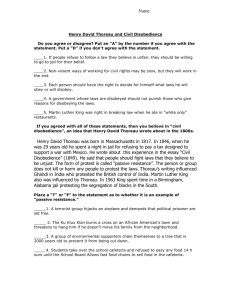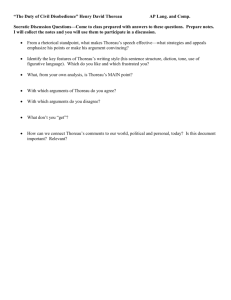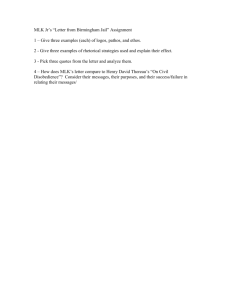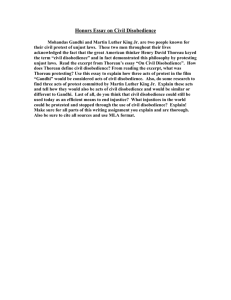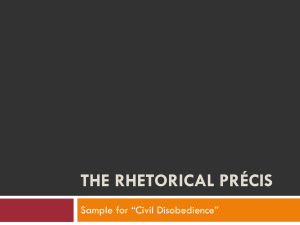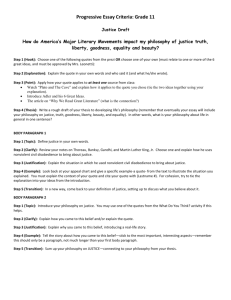DOMINANT IDEOLOGY REFLECTED IN THOREAU'S CIVIL
advertisement
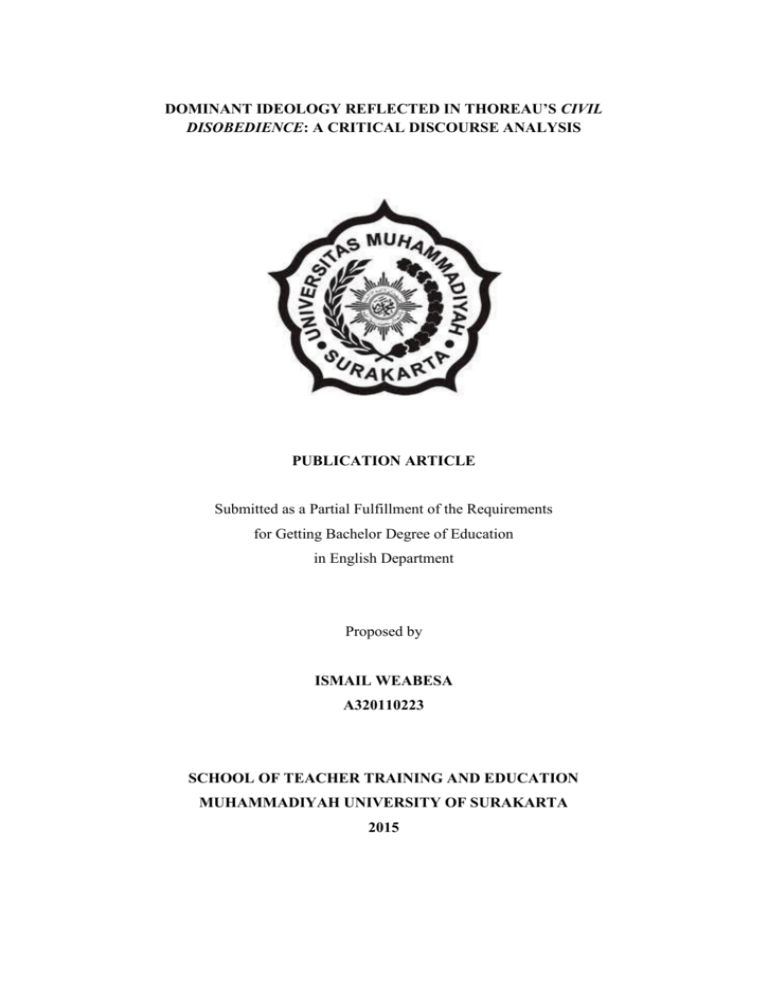
DOMINANT IDEOLOGY REFLECTED IN THOREAU’S CIVIL DISOBEDIENCE: A CRITICAL DISCOURSE ANALYSIS PUBLICATION ARTICLE Submitted as a Partial Fulfillment of the Requirements for Getting Bachelor Degree of Education in English Department Proposed by ISMAIL WEABESA A320110223 SCHOOL OF TEACHER TRAINING AND EDUCATION MUHAMMADIYAH UNIVERSITY OF SURAKARTA 2015 UNIVERSITAS MUHAMMADIYAH SURAKARTA FAKULTAS KEGURUAN DAN ILMU PENDIDIKAN Jl. A. YaniTromolPos 1 – Pabelan, KartasuraTelp. (0271) 717417 fax : 715448 Surakarta 57102 SURAT PERSETUJUAN ARTIKEL PUBLIKASI ILMIAH Yang bertanda tangan di bawah ini pembimbing skripsi/tugas akhir: Nama : Drs.M. Thoyibi, M.S NIK : 410 Nama : Titis Setyabudi S.S.,M. Hum NIK : 948 Telah membaca dan mencermati artikel publikasi ilmiah, yang merupakan ringkasan skripsi dari mahasiswa: Nama : ISMAIL WEABESA NIM : A320110223 Program studi : Bahasa Inggris Judul Skripsi : DOMINANT IDEOLOGY REFLECTED IN THOREAU’S CIVIL DISOBEDIENCE: A CRITICAL DISCOURSE ANALYSIS Naskah artikel tersebut, layak dan dapat disetujui untuk dipublikasikan. Demikian persetujuan dibuat, semoga dapat digunakan seperlunya. Surakarta, Juli 2015 Pembimbing I Dr. Drs.M. Thoyibi, M.S NIK: 410 Pembimbing II Titis Setyabudi S.S.,M. Hum NIK: 948 DOMINANT IDEOLOGY REFLECTED IN THOREAU’S CIVIL DISOBEDIENCE: A CRITICAL DISCOURSE ANALYSIS Ismail Weabesa A320110223 M. Thoyibi Titis Setyabudi Abstract The research paper studies about the dominant ideology. The study aims at classifying the structural element, social cognition and dominant ideology of Thoreau in his essay Civil Disobedience. The research paper is descriptive qualitative research. The object of the study is the dominant ideology of Thoreau in his essay Civil Disobedience. The data are the variation of the Thoreau’ essay, the data are derived from the Thoreau’s Civil Disobedience essay. The researcher applies the Critical Discourse Analysis or CDA in analyzing the data of the study. The result of the research shows that the dominant ideology of Thoreau in his Civil Disobedience essay is democracy ideology. The democracy ideology as the dominant ideology in Thoreau’s Civil Disobedience essay, it is got the effect from the heat circumstance of government in treating his civil. The Thoreau’s expression keyword for instance; Justice, Justly, Refuse, Resist, Against, Voting, Rights and Indifference have the closed meaning of the theory which were identified key concepts of democracy by Bühlmann and friends; equality; freedom; and “control”. Keywords: Dominant ideology, Critical Discourse Analysis, Democracy, Civil Disobedience. Introduction The government is the agent parties that serve the country, putting the policy to regulate the country’s vision. The government holds the rights to arrange the country’s vision and conducting the mission. The countries all around the world have a various kinds of government. Some countries set the democracy which is divided into two kinds. It’s monarchy which is prime minister as the governor and presidential governor. And the others set the dictatorship to govern the country. In the normally atmosphere, government serves the willing of people which is tended to regard the life as happiness and welfare, anything done by the government is considered only for the sake of the people. “I have suggested that they become particularly significant within contemporary programs, strategies and techniques for the government of conduct-forms of government that I have termed “advanced” liberal”(Rose 1999a) Ideology usually relates to the notions of power and dominance. Basically, ideology of the social representations was shaped by a group and it needs its beliefs and values to be accepted by those people who consent its power and dominance. Ideologies manipulate what is admitted as true or false, especially when such beliefs are established to be involved for the group of social. Gerald D Coleman (1985) with the title; Civil Disobedience: A moral critique. He concludes the Civil Disobedience as the nonviolent resisters can summarize their message in the following terms; we will take direct action against injustice, we will not obey unjust law or submit to unjust practice and we adopt the means of nonviolence because our end is a community at peace with itself. The writer uses Critical Discourse Analysis. Critical Discourse Analysis or we can abbreviate as CDA is the approach of interdisciplinary which to study the discourse or speech that observes the language as a formation of social practice (non-linguistics). It’s focusing on the examination how social dynamic connections was set up and strengthen via the usage of language. Critical discourse analysis (CDA) is a type of discourse analytical research that primarily studies the way social power abuse, dominance, and inequality are enacted, reproduced, and resisted by text and talk in the social and political context.(Van Dijk, 2001: 352) Research Method In doing the research, the writer uses descriptive qualitative study, intended to classify the object of the research. The data is in the Thoreau’s Civil Disobedience essay. The data source of this research are (1) Primary data, are the main data obtained from all the words, dialogues, phrases and sentences in the essay. The primary data sources of this analysis are Thoreau’s Civil Disobedience essay. (2) Secondary data are the supporting data taken from literary books, criticism, and some articles related to this essay. The secondary data of the research are taken from any information related to the essay. In analyzing data, the writer employs descriptive qualitative analysis of content. In conducting this study, the writer will use the techniques in collecting the data as follows: (1) Read the Thoreau’s Civil Disobedience essay repeatedly. (2) Taking notes of important part in both primary and secondary data. (3) Underlying the important word, phrases and sentences which are related to the study. (4) Managing and arranging the data into several parts based on its classification. (5) Selecting the data by rejecting the irrelevant information which does not support the topic of study. (6) Drawing the conclusion of the analysis that has already done in the former chapter and formulating its pedagogical suggestion. The steps of technique of the data analysis are compiled as follows: (1) Analyzing the structural elements of Thoreau’s Civil Disobedience essay. Focus will be paid on the structural analysis of the essay. (2) Trying to analyze Social cognition and historical context of the literary work. Focus will be paid on the meaning of dominant ideology. (3) Making discussion of the finding. (4) Making conclusion. The Result of the Research A. Structural analysis 1. Macrostructure The title of Henry David Thoreau’s literary work is expressed in noun phrase which combine of the two words. The first is “Civil” and second is “Disobedience” and it consists of the head (H) and the modifying (M). In the classification word of “Civil Disobedience” phrase, the word “Civil” is an Adjective and functioning as a modifying (M) and the word “disobedience” is a Noun and functioning as a Head (H). The word “Civil” modifies the word “Disobedience” and the word “Disobedience” stands as the Head (H) of this noun phrase as showing in the figure1 bellow. This phrase is concerned directly to the information in the text. “Civil Disobedience” with the meaning “people not reliance or conformity” is the acts of the people in the country which refuse or deny complying certain law, command or policy of the government. And it sometimes can be called the silent or nonviolent resistance to the government. As the writer had observed and analyzed Henry David Thoreau essay, the writer would like to give some outline of the essay. The writer divided the essay into three main propositions. The first proposition, democracy populist stands against the government policy on slavery and Mexican-war (paragraph 1-15). The second proposition, the writer quotes as transcendentalist rises up against unjust law (paragraph 1633) and the last proposition, the writer quotes as the citizens decide to allegiance or refuse allegiance of the state’s government (paragraph 34-43) 2. Superstructure The major form of text schema is argumentation. In Thoreau’s Civil Disobedience essay, argumentation stands as prominent and noticeable role. As far as we concerned, the main point in the essay is political dominant. The argument is the stale of political argument that have considered us for getting in mind. To make this essay clearly understand, we necessarily require several steps to get in sense of Thoreau’s argument; such as a reconstruction require to be based on the subjective argument and attitudes of the author. To get more comprehend this argument. However, we require more than reconstruction of Thoreau’s word. we can see that all of them are proposition which contains in the paragraph of the essay, and all of them are argumentative schema. As we can give more attention on its meaning, we can be clarified that all of its meaning are more close to what thematic or topic meaning are. 3. Microstructure Van Dijk (1988; 59) stated in his News as Discourse, the Microstructure level in the Critical Discourse Analysis distinguishes the meaning and expression about the word, phrase, clause and sentence from. In other word, microstructure is relevant to the sentence and sentence fragment. The writer found that Thoreau’s Civil Disobedience essay includes of four aspects of microstructure. They are semantic aspect, syntactic aspect, stylistic and rhetoric aspect. a. Semantic aspect 1) Background Background is one of the semantic elements in microstructure. Background is the scenery or ground sited behind something. It always tells the origin of the issue which will be descripted in every text and its aim to descript the atmospheres or the past incident, which explain what, how and why something or the issue happened. In this Thoreau’s essay, the background was used as the main argument in the text and it put in the first paragraph 2) Detail In Thoreau’s Civil Disobedience essay, we can found the detail element that was separated into three major propositions as mention in macrostructure. (1)The detail on democracy populist stands against the government policy on slavery and Mexican-war. (2) The detail on the transcendentalists rises up against unjust law. And (3) the details on citizens decide to allegiance or refuse allegiance of the state’s government. For example; “I have never declined paying the high way tax, because I am as desirous of being a good neighbor as I am of being a bad subject; and as for supporting schools, I am doing my part to educate my fellow-countrymen now. It is for no particular item in the tax-bill that I refuse to pay it. I simply wish to refuse allegiance to the state, to withdraw and stand aloof from it effectually”. (Paragraph 34) 3) Intention In Thoreau’s Civil Disobedience essay, intention is the Thoreau’s mental state that writes or represents a commitment to carrying out the way or overall strategy in the essay. For instance: Thoreau’s intention to uncover the government dysfunction and inexpedient (paragraph 1-3), to give an opinion on the standing of the army (paragraph 4-7), to declare American’s Revolution (paragraph 8), and to argue the voting for abolition of slavery law. (paragraph. 11) 4) Presumption In this subsection, the writer brings you Thoreau’s presumption which includes in Thoreau’s Civil Disobedience essay as classified below: His assumption about American government is just a tradition “This American government-what is it but a tradition, though a recent one, endeavoring to transmit itself unimpaired to posterity, but each instant losing some of its integrity? It has not the vitality and force of a single living man; for a single man can bend it to his will”. (Paragraph 2) b. Syntactic aspect 1) Sentence Construction It contains of declarative, interrogative, imperative and exclamatory sentence. Thoreau writes this essay grammatically. In one sentence of Thoreau, it contains subject, predicate, object and some sentence consists of complement. It can be found that sometimes subject and object were placed at the beginning of the sentence and some sentence they were placed at the end of it. 2) Coherence Due to the elements in syntactic explored in microstructure of Critical Discourse Analysis, coherence is expressed in the syntactic level of microstructure. There are at least three levels of coherence in Thoreau’s Civil Disobedience essay. They are discourse or interparagraph level, paragraph level and sentence level. (1) Discourse or inter-paragraph level: considering the uses of the word “after all”, “thus”, “however”, and “as for”. They are functioning as the combination of the two paragraphs in the discourse which have relevant meaning and context. (2) Paragraph level: considers the combination of semi-colon (;) and the sentence conjunction which uses the word “and” and “but” (3) sentence level: considering the uses of the mark colon ( : ) semi-colon ( ; ) and comma ( , ). They are functioning as the combination of the two clauses in the sentence which have relevant meaning and context. 3) Pronoun The usage of pronoun in the sentence of Thoreau’s Civil Disobedience essay, Thoreau uses them refer to something or someone and Thoreau also uses to refer to himself. There are several pronouns that are often utilized by Thoreau in his essay such as: I, You, We and They; “I” refers to Thoreau himself and refers not only to Thoreau but also refers to someone else through reported speech. “You” refers directly to the second person, the reader or whoever reads his essay. Second he uses the pronoun “you” not directly refer to the second person or reader but he mentions as reported speech. “We” refers to (1) He and the American people which is mentioned 10 times, (2) refers to Thoreau and his state’s government which is mentioned 7 times and the last “we” refers to him and his fellowprisoner which is only mentioned just once. “They” refers to American people 30 times, to the Government’s state 13 times, to Townsmen 6 times, to the Abolitionists 3 times, to the Statesmen and Legislator 3and to Rhine stream one time. c. Stylistic aspect 1) Lexicon Thoreau conveyed the lexicon in his essay. His words selected are; “unjust “Government”, law”, “slavery”, “inexpedient”, “injustice”, “people”, “Democracy”, “citizen”, “law”, “abolitionist”, “majority”, “right”, “allegiance”, “tax”, “minority”, “power”, “authority”, and “jail” or “imprison” For instance: “Such a man as an American government can make” (paragraph 4) “Law never made men a whit more just” (paragraph 4) “When the power is once in the hands of the people” (paragraph 4) “To speak practically and as a citizen” (paragraph 3) “And all government, are sometimes, inexpedient” (paragraph 1). Slavery is social factors that also determine language variations. Slavery reflects to the social status which is classed to the lower and labor class and discriminating between high society class and lower or laborer society class. Thoreau agrees on the abolition of the slave system. He also claims that American government is nothing but belongs to slavery government. d. Rhetoric aspect 1) Metaphor In Thoreau’s Civil Disobedience essay, it could be found any metaphor or simile that he mentions in his essay. For instance: “The mass of men serve the state thus, not as the men mainly, but as machines, with their bodies”. (Paragraph 5) The sentence which is mentioned by Thoreau above shows the metaphor. Thoreau would like to indicate the word “but as machines, with their bodies” to the military, police, jailers, constables or posse. They are the mass men who serve and stable the country 2) Other expression In this essay it could be given a concentration on the interjection of “ay”. The interjection of “ay” is used to give an expression of misery, shock, dismay or surprise. For example; “I know this well, that if one thousand, if one hundred, if ten men whom I could name, if ten honest men only, ay, if one honest man, in this state of Massachusetts” (paragraph 21). Thoreau mentions the interjection of “ay” to express emotion of dismay. B. Social cognition, historical context and dominant ideology 1. Social Cognition Due to Thoreau’s Civil Disobedience essay, the social cognition related to the background of Thoreau. Social cognition represents the particular formation such as; attitude, opinion and ideology which presumed knowledge, belief, norm and values of Thoreau. Henry David Thoreau is a man of introspective. He walks around the small village of concord, Massachusetts. Henry David Thoreau was born into a modest New England family. When he was a childhood he was surrounded by rivers, woods, and meadows, he became a greedy student of nature. 2. Historical context Handling with the issue arguments that were discussed in Thoreau’s Civil Disobedience essay, Historical context involved with the government, civil, law, tax, slavery, Revolution, liberty. Those issues were the critical issues that must be revealed in this chapter of discussion and finding. 3. Dominant ideology The ideology of Thoreau which is written in his Civil Disobedience essay contains of Capitalism, Nationalism, Democracy and Liberalism. In his essay the great number and highest rated ideology which composed by Thoreau is Democracy ideology. The researcher gives conclusion that the dominant ideology of Thoreau which is written in the essay is Democracy ideology. This democracy ideology represented gesture of Thoreau toward his people and especially his government. Conclusion According to the problem statement which the writer proposed, the writer composed that the main problems in this research are: (1) “What is the dominant ideology reflected in Thoreau’s Civil Disobedience?” and (2) “How is dominant ideology reflected in Thoreau’s Civil Disobedience?” The writer will describe the problem statement one by one. First, what is the dominant ideology reflected in Thoreau’s Civil Disobedience? According to the writer had observed Thoreau’s Civil Disobedience essay and analyzed structural element in chapter III and social cognition, historical context and dominant ideology in chapter IV, the writer conclude that the dominant ideology reflected in Thoreau’s Civil Disobedience is democracy ideology. While the democracy ideology was composed in the essay, it is may concerned and influenced the liberalism ideology. Second, how is dominant ideology reflected in Thoreau’s Civil Disobedience? The democracy ideology as the dominant ideology in Thoreau’s Civil Disobedience essay, it is got the effect from the heat circumstance of government in treating his civil. The Thoreau’s expression keyword for instance; Justice, Justly, Refuse, Resist, Against, Voting, Rights and Indifference have the closed meaning of the theory which were identified key concepts of democracy by Bühlmann and friends; equality; freedom; and “control”. Reference Bühlmann, Marc / Wolfgang Merkel / Bernhard Wessels .2008. The Quality of Democracy. Democracy Barometer for Established Democracies. (Revised Version 20.03.2008). National Center of Competence in Research: Challenges to Democracy in the 21st Century: Working Paper No. 10a. Fairclough, N. L. and Wodak, R. (1997). Critical discourse analysis. In T. A. Van Dijk(ed.), Discourse Studies. A Multidisciplinary Introduction, Vol. 2. Discourse as social Interaction (pp. 285-84). London: Sage. Fairclough, Norman.2003. Analysing Discourse: Textual Analysis for Social Research. London: Routledge. Goldfard, Norman M..2008. “Individual Vs. Community Rights in Clinical Research”. Taylor and Francis. Vol.4, No.10. Kintsch, W., & van Dijk, T. A. (1978). Toward a model of text comprehension and production. Psychological Review, 85, 363-394. Mahler, G.S.1995. Comparative politics: An instructional and cross-national approach. Englewood Cliffs, NJ: Prentice Hall. Rose, N.1999a. Power of freedom : Reframing Political Thought. Cambridge: Cambridge University Press. Sargent, Lyman Tower. 1987. Contemporary Political Ideologies. California: Brooks/Cole Publishing company. Simpson, J.A. and Weiner, E.S.C. 1991. The compact oxford dictionary, 2nd ed. Oxford: GB:Clarendon press. Sodaro, Michael J. 2004. Comparative Politics. A Global Introduction. New York: Mc Graw Hill. Thoreau, H. D. 2014. Walden and Civil Disobedience. San Diego CA: Baker@Taylor Publishing Group. Van Dijk, T.A.1972. Some aspects of text grammars. The Haque: Mauton. Van Dijk, T.A. 1977. Text and Context. London: Longman. Van Dijk, T.A.1980a. Macrostructures. Hillsdale, NJ: Lawrene Erlbaum Associates. Van Dijk, T.A.2001. Critical Discourse Analysis. In Deboreh Schiffrin and friends(Eds), The Handbook of Discourse Analysis (pp371-352).UK: Blackwell Publisher. Van Dijk, T.A.1988. News as Discourse. Hillsdale, NJ: Lawrene Erlbaum Associates. VIRTUAL REFERENCES Wendy, M. (2005). Henry Thoreau and civil disobedience. Thoreau.eserver.org/wendy.html, 6 April 2015, 20:23 PM From Smith, Nichole. (2011). Analysis and Summary of “Civil Disobedience” by Henry David Thoreau. From www.articlemariad.com/analysis-summary-civildisobedience/, 6 April 2015, 10:00 AM Slavery in America. http://www.history.com/topics/black-history/slavery: access 6 July 2015, 15:25 PM
